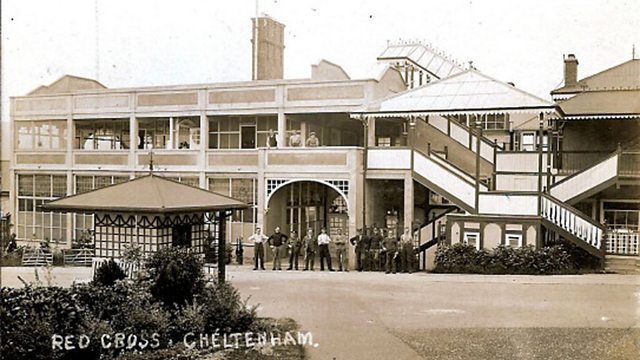Cheltenham Racecourse, Gloucestershire: War Hospital
By the end of the war, the staff had treated more than 3,000 patients
When war broke out a well-rehearsed plan was put into action to set up hospitals throughout the UK. Initially they were intended to supplement the main military hospitals by providing beds for soldiers (walking wounded) who were in need of convalescence.
By October 1914, a steady stream of casualties were already being transported back to England and when a mass evacuation from around Antwerp was necessary it was obvious that military and civilian hospitals did not have the resources needed. Frantic preparations to turn private houses and schools into Voluntary Aid (VA) Hospitals began.
Each VA hospital had a commandant who was in effect the matron and administrator. Staff were usually from a single voluntary aid detachment (VAD), with some trained nurses, and the rest being volunteers who came from all walks of life. Transport was normally provided by men’s detachments but women would also drive ambulances and delivery vans.
There was no shortage of volunteers and by the summer of 1914 there were some 2,500 VADs manned by 74,000 volunteers, of which at least two thirds were female. They were trained to organise transport as well as provide food and dressings for ambulance trains. Setting up emergency field kitchens and even auxiliary hospitals were part of their responsibilities.
It opened on 28 October 1914, and was the fifth such facility to open in the county. Thirteen Belgian and two British patients were the first to be accommodated in an upstairs ward, formerly known as the Ladies Drawing Room. The following day 16 more patients arrived and the Old Luncheon Room was opened. Early November saw the opening of the Large Luncheon Room with its veranda and annex. These three wards provided 100 beds. The number of beds was increased in April 1917 to 150, and in 1918 to 200, plus emergency beds.
It was classed as a primary hospital and received cases direct from the port of disembarkation. By 28 February 1919 there had been 3,169 admissions with just 18 deaths. Of these admissions: 2,677 were British, 249 Australian, 101 Belgian, 128 Canadian, seven American, six pensioners and one naval. The average number of resident patients at any one time was between 102 and 175, each staying an average of about 50 or 60 days. Eighteen of the staff worked continuously from the day the hospital opened until its closure on 28 February 1919.
Location: Cheltenham Racecourse GL50 4SH
Image shows Cheltenham Racecourse during WW1, courtesy of Geoff North
Presented by Edward Gillespie
Duration:
Credits
| Role | Contributor |
|---|---|
| Presenter | Edward Gillespie |
This clip is from
Featured in...
![]()
Βι¶ΉΤΌΕΔ Radio Gloucestershire—World War One At Βι¶ΉΤΌΕΔ
Places in Gloucestershire that tell a story of World War One
More clips from World War One At Βι¶ΉΤΌΕΔ
-
![]()
The loss of HMY Iolaire
Duration: 18:52
-
![]()
Scotland, Slamannan and the Argylls
Duration: 07:55
-
![]()
Scotland Museum of Edinburgh mourning dress
Duration: 06:17
-
![]()
Scotland Montrose 'GI Brides'
Duration: 06:41







